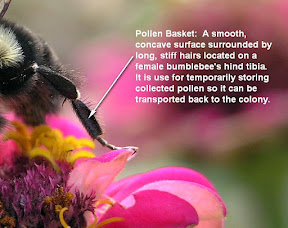Mantis
by Jo
11/8/09
Wet Squirrel
Buck in the Garden
My World: Low Clouds Over Bear Creek Valley
 Female bees (queens and workers) in family Apidae (honey bees, carpenter bees, bumblebees and several lesser known groups) have specialized structures called pollen baskets (corbicula) used for temporarily storing collected pollen so it can be transported back to the nest/colony. The pollen basket is a smooth, concave structure surrounded by long, stiff hairs located on the tibia of the bee's two rear legs. As the bee visits flowers, she accumulates pollen all over her body. She uses her legs to aggregate the pollen and transfer it to her pollen basket. It may look as if a bee simply has hairy legs, but some of those hairs (setae) are actually combs and brushes used for transferring pollen. The pollen is combed, pressed, compacted, and transferred to her pollen basket. Honey and/or nectar is used to moisten the dry pollen so it will stay in place.
Female bees (queens and workers) in family Apidae (honey bees, carpenter bees, bumblebees and several lesser known groups) have specialized structures called pollen baskets (corbicula) used for temporarily storing collected pollen so it can be transported back to the nest/colony. The pollen basket is a smooth, concave structure surrounded by long, stiff hairs located on the tibia of the bee's two rear legs. As the bee visits flowers, she accumulates pollen all over her body. She uses her legs to aggregate the pollen and transfer it to her pollen basket. It may look as if a bee simply has hairy legs, but some of those hairs (setae) are actually combs and brushes used for transferring pollen. The pollen is combed, pressed, compacted, and transferred to her pollen basket. Honey and/or nectar is used to moisten the dry pollen so it will stay in place.Pollen Baskets (Corbicula)
Woolly Bear Caterpillar Predicting the Weather in My World
 Species Identification: Typically four black spots on pronotum (short body segment between head and thorax) ... two spots toward the outer edges and two that blend together in the center ... iridescent green elytra (wing covers) ... approximately 5mm (1/4") long.
Species Identification: Typically four black spots on pronotum (short body segment between head and thorax) ... two spots toward the outer edges and two that blend together in the center ... iridescent green elytra (wing covers) ... approximately 5mm (1/4") long.Flea Beetle - Kuschelina gibbitarsa
Hawaiian Beet Webworm Moth - Spoladea recurvalis
SkyWatch Friday: In The Pink
Nature Notes: Baldfaced Hornet - Dolichovespula maculata
My World Is Foggy
Differential Grasshopper - Melanoplus differentialis - Female
Melonworm Moth - Diaphania hyalinata
Nature Notes: Pipevine Swallowtail (Battus philenor)
